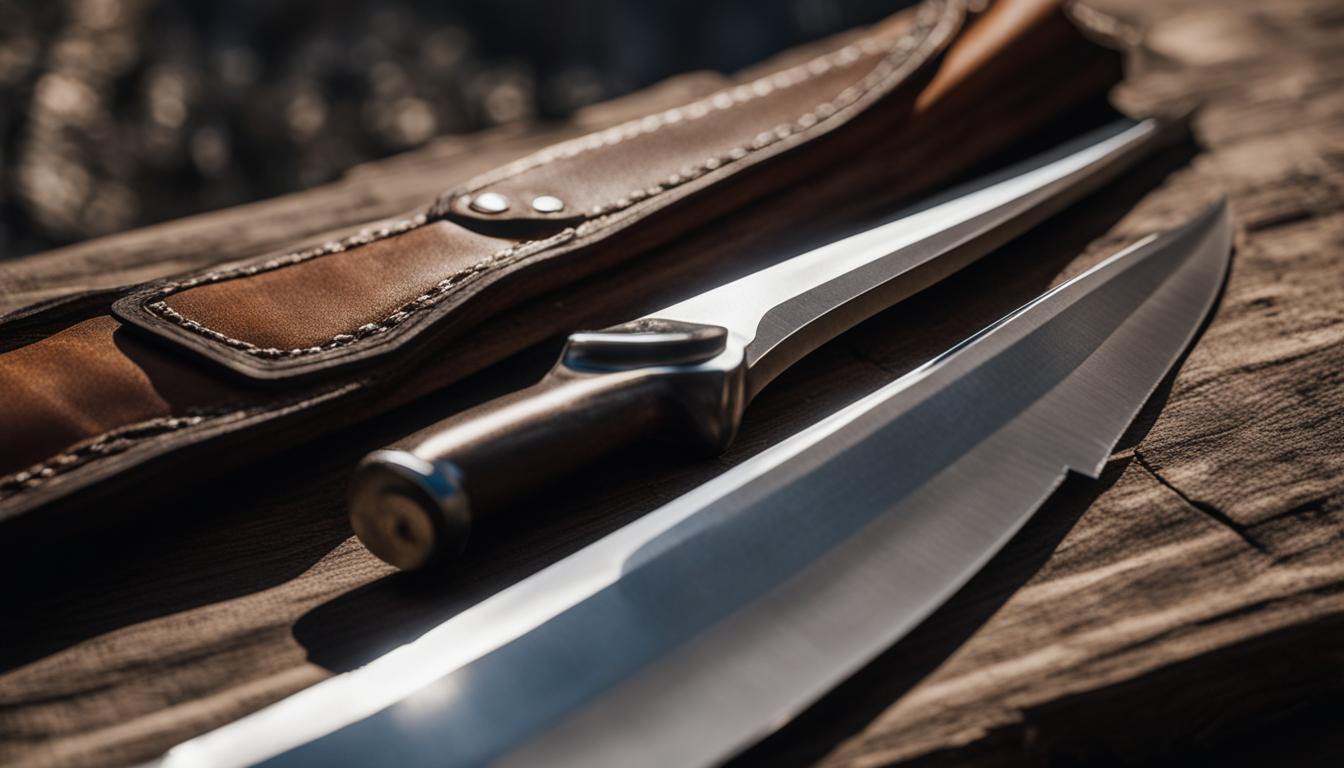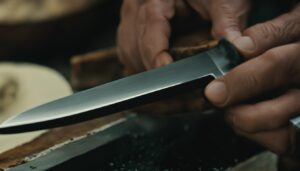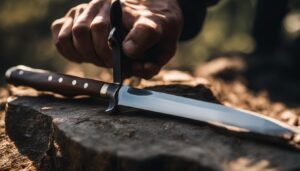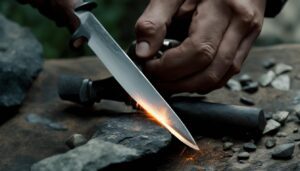Sharpening your hunting knife is an essential skill that can save you time and energy in the field. There are different tools available for sharpening, including sharpeners, steel sharpeners, and sharpening stones. Each tool has its advantages and disadvantages, so it’s important to choose the one that suits your needs and skills. The sharpening angle for a hunting knife is recommended to be between 25-30 degrees. Regularly sharpening your knife will help maintain its sharpness and effectiveness.
Key Takeaways:
- Hunting knife sharpening is a crucial skill for saving time and energy in the field.
- Choose the right sharpening tool based on your needs and skills.
- The recommended sharpening angle for a hunting knife is between 25-30 degrees.
- Regularly sharpen your knife to maintain its sharpness and effectiveness.
- Stay tuned for the upcoming sections to learn more about the different tools and techniques for sharpening your hunting knife.
The Different Tools for Sharpening Your Knife
When it comes to sharpening your hunting knife, there are three main tools you can use: sharpeners, steel sharpeners, and sharpening stones. Each tool has its own advantages and disadvantages, so it’s important to understand their differences before choosing the right one for you.
Sharpeners are the easiest and fastest way to sharpen your knife. They usually consist of a handheld device with built-in sharpening elements. However, they may not provide the best angle for a hunting knife, making them more suitable for quick touch-ups rather than a complete sharpening.
Steel sharpeners, also known as honing rods, require more time and expertise but offer more control over the sharpening angle. With a steel sharpener, you have the flexibility to choose your own angle, which is crucial for achieving the optimal sharpness for your hunting knife. This tool is recommended for experienced sharpeners who want precise control over their sharpening process.
Sharpening stones, specifically water stones, are another popular choice for sharpening hunting knives. These stones are known for their ability to both sharpen and polish the knife, resulting in a precise and refined edge. They require more practice and patience to master but offer excellent results. Water stones are recommended due to their ability to keep the blade and stone clean during the sharpening process.
| Tool | Advantages | Disadvantages |
|---|---|---|
| Sharpeners | Easy and fast to use | May not provide the best angle for hunting knives |
| Steel sharpeners | Allows control over sharpening angle | Requires more time and expertise |
| Sharpening stones | Provides precise and refined edge | Requires practice and patience to master |
Choosing the right tool for sharpening your hunting knife depends on your skill level, desired sharpness, and personal preference. Whether you opt for the convenience of sharpeners, the control of steel sharpeners, or the precision of sharpening stones, regular maintenance of your knife’s edge is crucial for optimal performance in the field.
How to Sharpen Your Knife with a Sharpening Steel
Sharpening your hunting knife with a sharpening steel is a technique that requires precision and attention to detail. By following the proper steps, you can ensure that your knife remains sharp and effective in the field. Here’s a step-by-step guide on how to sharpen your knife using a sharpening steel:
Step 1: Proper Grip
Start by holding the sharpening steel in one hand and the knife in the other. Place the blade on the steel at a 25-30 degree angle, with your thumb resting on the back of the blade for stability.
Step 2: Slide and Repeat
Using a smooth and controlled motion, slide the blade from the bottom to the top of the sharpening steel. Repeat this motion 3 to 4 times on each side of the blade. Remember to maintain a consistent angle and avoid changing it with each stroke.
Step 3: Monitor Progress
Regularly wipe off any metal residue on the blade and inspect the edge for sharpening progress. You should see a noticeable improvement in the sharpness and effectiveness of the knife as you continue to sharpen it with the steel.
It’s important to note that using a sharpening steel is best for regular maintenance and touch-ups. If your knife is excessively dull or damaged, it may require more intensive sharpening with a sharpening stone. Regularly sharpening your hunting knife with a sharpening steel will help keep it in optimal condition for your outdoor adventures.
| Pros of Sharpening Steel | Cons of Sharpening Steel |
|---|---|
| Quick and easy to use | May not provide the best angle for a hunting knife |
| Portable and convenient | Requires practice and technique for optimal results |
| Great for regular maintenance | Not suitable for heavily damaged or dull knives |
Sharpening your hunting knife with a sharpening steel is an effective way to maintain its sharpness and effectiveness. With practice and attention to detail, you can master this valuable skill and ensure that your knife is always ready for your outdoor pursuits.
How to Sharpen Your Knife with a Sharpening Stone
Sharpening your hunting knife with a sharpening stone is a traditional and effective method that allows for precise reshaping and polishing of the blade. To get started, you’ll need a sharpening stone, specifically a water stone, which is known for its ability to provide both sharpening and polishing capabilities. Before you begin, soak the stone in water for 10-15 minutes to ensure optimal performance.
Once the stone is ready, wet it throughout the sharpening process to create a smooth surface for the knife. It’s important to choose a stone with a coarser grain to reshape the edge of the blade and a finer grain to refine and polish it to a precise finish. The coarser grain removes any dullness and imperfections, while the finer grain hones the edge for optimal sharpness.
When using the sharpening stone, hold the knife at a consistent angle, typically between 25-30 degrees, and apply light pressure as you move the blade across the stone. Start from the tip and slide the knife towards the heel, maintaining the angle throughout the process. This motion ensures that the entire length of the blade is sharpened evenly.
| Step | Instructions |
|---|---|
| 1 | Soak the sharpening stone in water for 10-15 minutes. |
| 2 | Wet the stone throughout the sharpening process. |
| 3 | Select a coarser-grained side to reshape the edge of the blade. |
| 4 | Hold the knife at a consistent angle, typically 25-30 degrees. |
| 5 | Slide the knife from the tip to the heel, maintaining the angle. |
| 6 | Repeat the process on the finer-grained side for polishing. |
| 7 | Regularly add water to the stone to maintain a smooth surface. |
Throughout the sharpening process, regularly check the sharpness of the blade by lightly running your finger along the edge. Be cautious and avoid applying too much pressure, as a sharp knife can easily cut through skin. Once you are satisfied with the sharpness, clean the blade and dry it thoroughly to remove any metal residue or moisture.
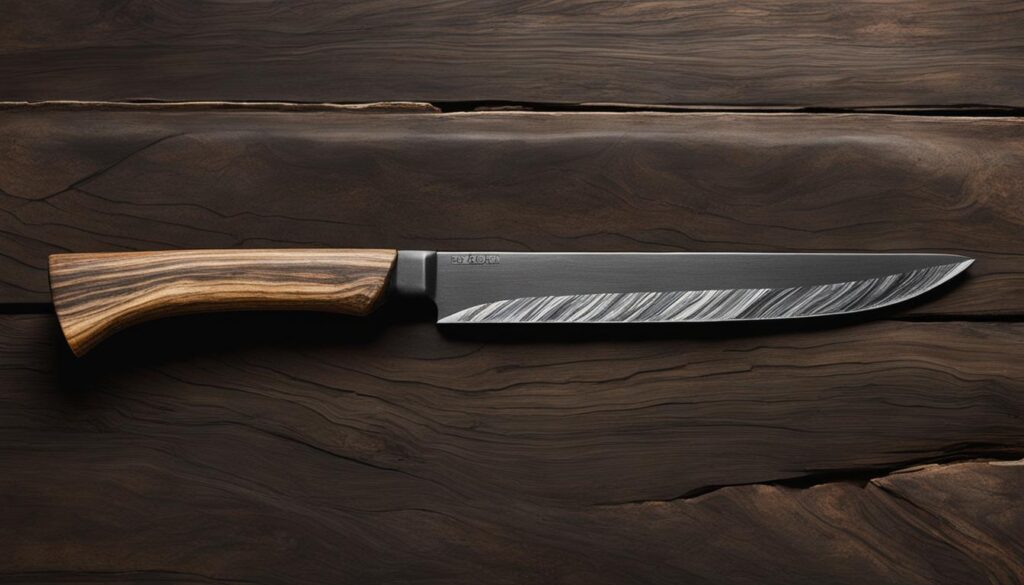
Sharpening your hunting knife with a sharpening stone is a skill that requires practice and attention to detail. With proper technique and the right equipment, you can ensure that your knife is always ready for the demands of the great outdoors.
Tips for Successful Knife Sharpening
Sharpening your hunting knife requires attention to detail and proper technique. Here are some tips to ensure successful knife sharpening:
- Choose the right sharpening tool: There are various tools available for sharpening knives, including sharpeners, steel sharpeners, and sharpening stones. Depending on your skills and preferences, select the tool that suits your needs and provides the desired sharpness.
- Maintain a consistent angle: When sharpening your knife, it is important to maintain a consistent angle throughout the process. This ensures an even and precise sharpening, resulting in a sharp and effective blade.
- Use light pressure: Applying excessive pressure while sharpening can lead to uneven results and damage to the blade. Use gentle and controlled pressure to achieve the desired sharpness.
- Regularly wipe off metal residue: During the sharpening process, metal residue can accumulate on the blade, affecting the quality of the sharpening. Regularly wipe off the residue to maintain a clean and sharp edge.
- Monitor the sharpness of the blade: Keep a close eye on the sharpness of the blade while sharpening. Check the progress regularly and make adjustments as needed to achieve the desired level of sharpness.
By following these tips, you can ensure successful knife sharpening and keep your hunting knife in optimal condition for your outdoor adventures.
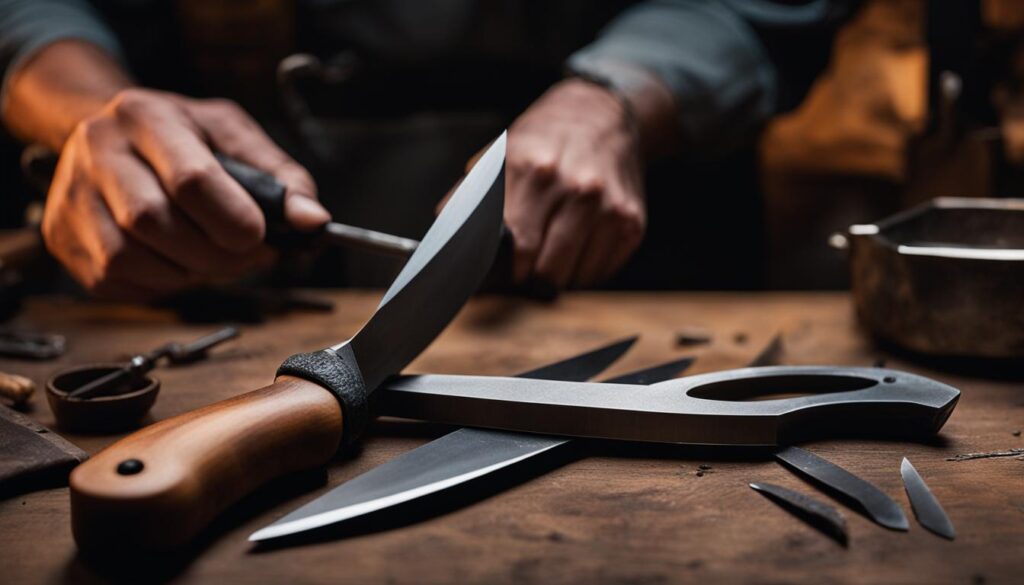

Expert Quote:
“Proper knife sharpening technique is crucial for maintaining a sharp and effective blade. By choosing the right tools and following the right steps, you can ensure that your hunting knife is always ready for any task.” – Knife Sharpening Expert
Now that you have learned some valuable tips for successful knife sharpening, you can confidently maintain the sharpness of your hunting knife. Remember to choose the right sharpening tool, maintain a consistent angle, use light pressure, regularly clean off metal residue, and monitor the sharpness of the blade. With these techniques, you’ll be well-equipped for your next hunting adventure.
The Importance of Regular Knife Sharpening
Regularly sharpening your hunting knife is essential for maintaining its effectiveness and longevity. A sharp knife requires less force and movement, allowing for more precise cutting and reducing the risk of accidents. However, the frequency of sharpening depends on the knife’s usage and the tasks it is used for.
As a general guideline, it is recommended to sharpen your knife every 18-24 months. However, if you frequently use your knife for heavy-duty tasks such as dressing game or cutting through tough materials, more frequent sharpening may be necessary. Regular sharpening not only keeps your knife in optimal condition but also saves you time and effort in the long run.
By regularly maintaining the sharpness of your knife’s edge, you ensure that it is always ready for your outdoor adventures. Whether you’re hunting, camping, or engaging in other outdoor activities, a sharp knife is an indispensable tool.
Benefits of Regular Knife Sharpening
Regular knife sharpening offers several benefits that enhance both your safety and overall experience. Here are some key advantages:
- Improved Cutting Performance: A sharp knife cuts more efficiently, requiring less force and reducing the risk of slippage or accidents.
- Enhanced Precision: With a sharp knife, you can achieve precise and clean cuts, whether you’re field-dressing game or preparing food during a camping trip.
- Extended Lifespan: Regularly sharpened knives maintain their structural integrity for longer periods, reducing the need for frequent replacements.
- Reduced Maintenance: A sharp knife requires less maintenance, as it effortlessly performs its intended tasks without straining the blade or handle.
Choosing the Right Sharpening Method
There are various methods and tools available for sharpening hunting knives, each with its own advantages. The choice ultimately depends on your personal preference and skill level. Whether you opt for a sharpening steel, sharpening stone, or other sharpening tool, regular maintenance should remain a priority.
Remember, practice and consistency are key to mastering the art of knife sharpening. With proper techniques and tools, you can ensure that your hunting knife remains in optimal condition, always ready to tackle the challenges of the great outdoors.
Table: Recommended Sharpening Frequency
| Type of Knife | Frequency of Sharpening |
|---|---|
| Hunting Knife | Every 18-24 months |
| Camping Knife | Every 12-18 months |
| Survival Knife | Every 12-18 months |
Conclusion
After mastering the art of hunting knife sharpening, you’ll be well-equipped for your outdoor adventures. Whether you choose to use a sharpening steel or a sharpening stone, regular maintenance of your knife’s edge is crucial for optimal performance in the field. By following the proper techniques and staying vigilant about maintaining a sharp blade, you can ensure that your hunting knife is always ready for action.
Sharpening your hunting knife with a sharpening steel is a skill that can be perfected with practice. The sharpening angle for a hunting knife is recommended to be between 25-30 degrees. Holding the sharpener and knife correctly and maintaining a consistent angle are key to achieving a sharp edge. With each stroke, slide the blade from the bottom to the top of the steel, repeating the motion on each side. Regularly wipe off any metal residue and monitor the progress of the sharpening.
Alternatively, using a sharpening stone, particularly a water stone, can also yield excellent results. Soak the stone in water before starting and wet it throughout the process. Choose a coarser grain stone to reshape the edge and a finer grain stone to refine and polish the blade. Maintain a steady motion from tip to heel while applying light pressure. Keep an eye on the sharpness of the blade and add water to the stone as needed.
Remember, regular knife sharpening is essential for maintaining effectiveness and longevity. A sharp hunting knife requires less force and movement, making cutting tasks more precise and reducing the risk of accidents. Plan to sharpen your knife every 18-24 months, but adjust based on frequency of use and the tasks it performs. With consistent care, your hunting knife will always be ready to tackle the challenges of the great outdoors.
FAQ
What is the best tool for sharpening a hunting knife?
The best tool for sharpening a hunting knife depends on your needs and skills. Sharpeners are the easiest and fastest option, but may not provide the best angle. Steel sharpeners allow you to choose your own angle but require more time and expertise. Sharpening stones, specifically water stones, are recommended for their ability to sharpen and polish the knife with precision.
How do I use a sharpening steel?
Hold the sharpener in one hand and the knife in the other. Place the blade on the steel with your thumb on the back of the blade. Slide the blade from the bottom to the top of the steel, repeating the motion 3 to 4 times on each side. Maintain a consistent angle and avoid changing it with each stroke. Regularly wipe off metal residue and monitor the edge of the blade for sharpening progress.
How do I use a sharpening stone?
Start by soaking the stone in water for 10-15 minutes. Wet the stone throughout the sharpening process and choose a coarser grain to reshape the edge of the knife and a finer grain to refine and polish the blade. Use a consistent motion from tip to heel, maintaining the angle and applying light pressure. Regularly add water to the stone and monitor the sharpness of the blade.
How often should I sharpen my hunting knife?
It is recommended to sharpen your hunting knife every 18-24 months, depending on its frequency of use and the tasks it is used for. Regular sharpening will maintain the knife’s effectiveness and save you time and effort in the long run.
Why is regular knife sharpening important?
Regular knife sharpening is essential for maintaining the knife’s effectiveness and longevity. A sharp knife requires less force and movement, allowing for more precise cutting and reducing the risk of accidents. By keeping your knife sharp, you ensure it is always ready for your hunting adventures.
